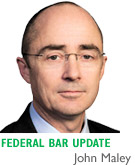Subscriber Benefit
As a subscriber you can listen to articles at work, in the car, or while you work out. Subscribe Now
 As previewed in prior columns, effective Dec. 1 various amendments took effect to the Federal Rules of Civil Procedure (as well as appellate, criminal, and evidence rules). Rule 26 was amended to apply work-product protection to the discovery of draft expert reports. Rule 56 amendments are significant but do not change summary judgment standards or burdens.
As previewed in prior columns, effective Dec. 1 various amendments took effect to the Federal Rules of Civil Procedure (as well as appellate, criminal, and evidence rules). Rule 26 was amended to apply work-product protection to the discovery of draft expert reports. Rule 56 amendments are significant but do not change summary judgment standards or burdens.
When federal rules are amended, pursuant to 28 U.S.C. § 2074, the amended “rule shall take effect no earlier than December 1 of the year in which such rule is so transmitted unless otherwise provided by law. The Supreme Court may fix the extent such rule shall apply to proceedings then pending, except that the Supreme Court shall not require the application of such rule to further proceedings then pending to the extent that, in the opinion of the court in which such proceedings are pending, the application of such rule in such proceedings would not be feasible or would work injustice, in which event the former rule applies.”
As the Supreme Court has done in prior years, with these amendments the court stated in its amendment order that the “foregoing amendments to the Federal Rules of Civil Procedure shall take effect on December 1, 2010, and shall govern all proceedings thereafter commenced and, insofar as just and practicable, all proceedings then pending.”
Thus, the new rules apply to all new cases from Dec. 1 forward and to all pre-existing cases to the extent “just and practicable.” Courts typically look to “undue prejudice” in applying this standard. With respect to the current amendments in Rules 26 and 56, it is expected that the amendments will apply to pending cases.
Proper ecf Filing – In Green Mountain Financial Fund v. LaCroix, No. 1:09-CV-1216-SEB-TAB (Nov. 22, 2010), plaintiff filed a motion for summary judgment along with 16 supporting exhibits. The court struck the filing with leave to re-file for failure to comply with Local Rule 5.6 and paragraph 13 of the CM/ECF Policy and Procedure Manual, which states, “When uploading attachments during the electronic filing process … a brief description must be entered for each individual PDF file. The description must include not only the exhibit number or letter, but also a brief description of the document itself.”
In Green Mountain, plaintiff had labeled the supporting exhibits “A,” “B,” “C,” etc., but did not describe the exhibits. The court noted, “For example, Exhibit A might have been described as ‘Legal Description: Tract 1.’ Exhibit B might have been described as ‘Note, July 10, 2007.’” The court added, “When voluminous exhibits are not properly described, it is difficult and burdensome for the Court and other parties to this lawsuit to locate the exhibits electronically.” Accordingly, the court struck the filing with leave to re-file seven days later and tolled the responding parties’ response brief until such re-filing. •
__________
John Maley ([email protected]) is a partner with Barnes & Thornburg practicing federal and state litigation, employment matters, and appeals. The opinions expressed in this column are the author’s.
Please enable JavaScript to view this content.
